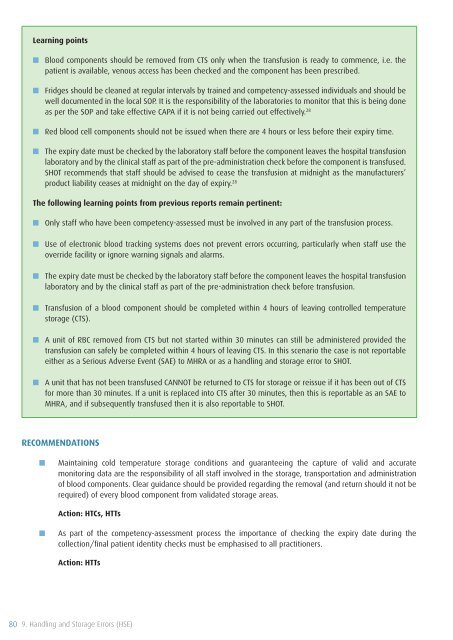SHOT Annual Report 2009 - Serious Hazards of Transfusion
SHOT Annual Report 2009 - Serious Hazards of Transfusion
SHOT Annual Report 2009 - Serious Hazards of Transfusion
You also want an ePaper? Increase the reach of your titles
YUMPU automatically turns print PDFs into web optimized ePapers that Google loves.
Learning points<br />
■■<br />
Blood components should be removed from CTS only when the transfusion is ready to commence, i.e. the<br />
patient is available, venous access has been checked and the component has been prescribed.<br />
■■ Fridges should be cleaned at regular intervals by trained and competency-assessed individuals and should be<br />
well documented in the local SOP. It is the responsibility <strong>of</strong> the laboratories to monitor that this is being done<br />
as per the SOP and take effective CAPA if it is not being carried out effectively. 28<br />
■■<br />
Red blood cell components should not be issued when there are 4 hours or less before their expiry time.<br />
■■ The expiry date must be checked by the laboratory staff before the component leaves the hospital transfusion<br />
laboratory and by the clinical staff as part <strong>of</strong> the pre-administration check before the component is transfused.<br />
<strong>SHOT</strong> recommends that staff should be advised to cease the transfusion at midnight as the manufacturers’<br />
product liability ceases at midnight on the day <strong>of</strong> expiry. 28<br />
The following learning points from previous reports remain pertinent:<br />
■■<br />
■■<br />
■■<br />
■■<br />
Only staff who have been competency-assessed must be involved in any part <strong>of</strong> the transfusion process.<br />
Use <strong>of</strong> electronic blood tracking systems does not prevent errors occurring, particularly when staff use the<br />
override facility or ignore warning signals and alarms.<br />
The expiry date must be checked by the laboratory staff before the component leaves the hospital transfusion<br />
laboratory and by the clinical staff as part <strong>of</strong> the pre-administration check before transfusion.<br />
<strong>Transfusion</strong> <strong>of</strong> a blood component should be completed within 4 hours <strong>of</strong> leaving controlled temperature<br />
storage (CTS).<br />
■■ A unit <strong>of</strong> RBC removed from CTS but not started within 30 minutes can still be administered provided the<br />
transfusion can safely be completed within 4 hours <strong>of</strong> leaving CTS. In this scenario the case is not reportable<br />
either as a <strong>Serious</strong> Adverse Event (SAE) to MHRA or as a handling and storage error to <strong>SHOT</strong>.<br />
■■ A unit that has not been transfused CANNOT be returned to CTS for storage or reissue if it has been out <strong>of</strong> CTS<br />
for more than 30 minutes. If a unit is replaced into CTS after 30 minutes, then this is reportable as an SAE to<br />
MHRA, and if subsequently transfused then it is also reportable to <strong>SHOT</strong>.<br />
RECOMMENDATIONS<br />
■■<br />
Maintaining cold temperature storage conditions and guaranteeing the capture <strong>of</strong> valid and accurate<br />
monitoring data are the responsibility <strong>of</strong> all staff involved in the storage, transportation and administration<br />
<strong>of</strong> blood components. Clear guidance should be provided regarding the removal (and return should it not be<br />
required) <strong>of</strong> every blood component from validated storage areas.<br />
Action: HTCs, HTTs<br />
■■<br />
As part <strong>of</strong> the competency-assessment process the importance <strong>of</strong> checking the expiry date during the<br />
collection/final patient identity checks must be emphasised to all practitioners.<br />
Action: HTTs<br />
80 9. Handling and Storage Errors (HSE)












